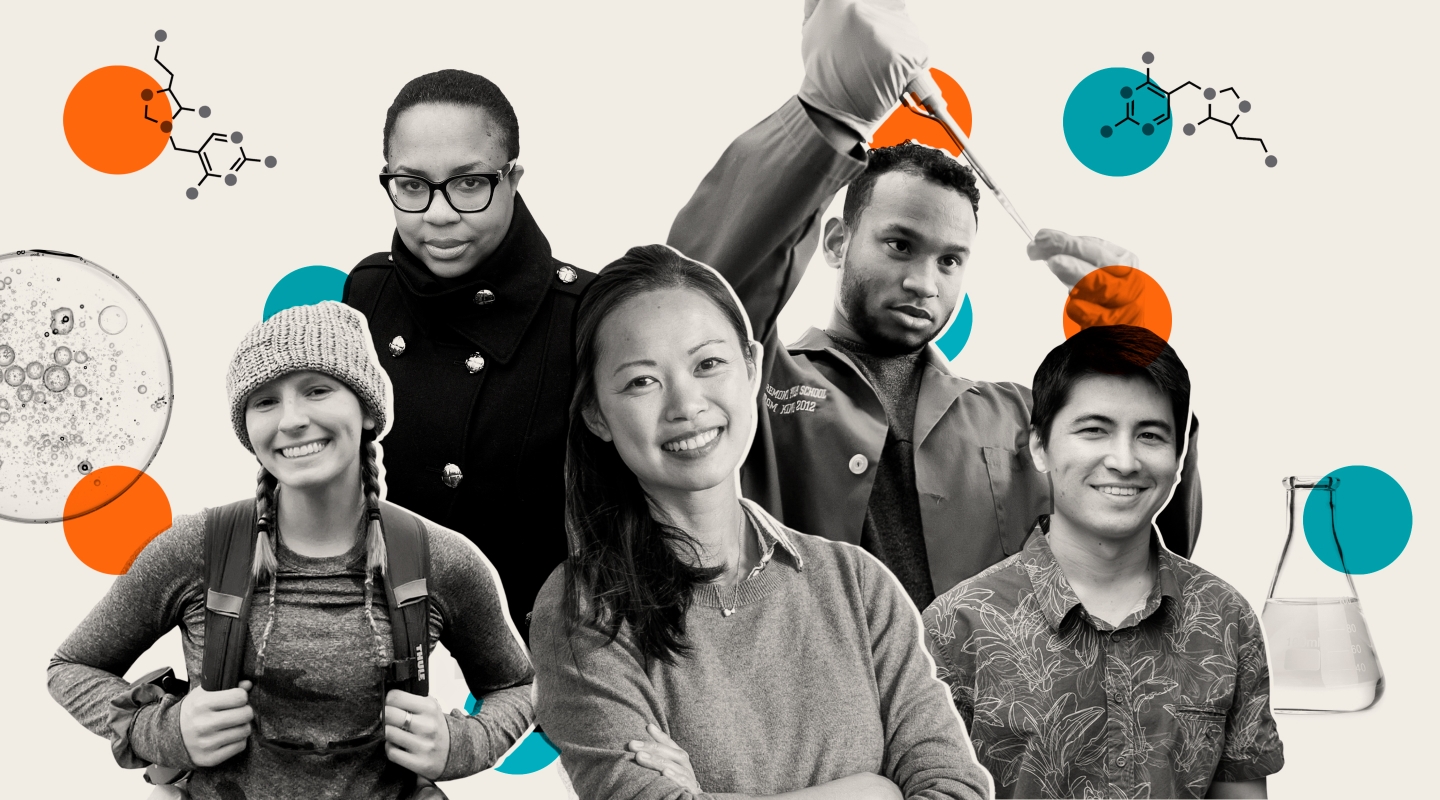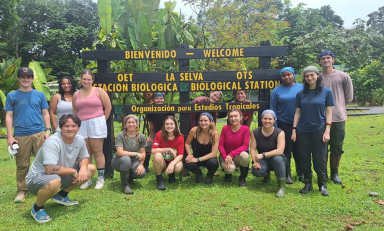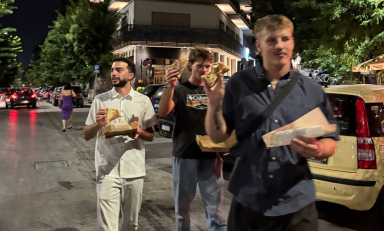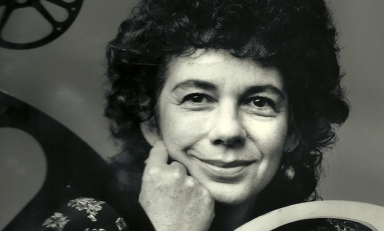Occidental’s labs are the launching pads for countless careers in the sciences—and here are 18 graduates of the last 20 years, nominated by their former faculty mentors, doing exemplary work in their field
Amelia Muscott ’22
“Growing up in Washington state, I always wondered about the history of the Cascade Range and its precipitous peaks, the rugged topography of the channeled scablands, and the formation of columnar basalt,” says Amelia Muscott. At the beginning of her sophomore year at Oxy, she began working in Associate Professor of Geology Darren Larsen’s paleoclimate and sedimentology lab having taken only a few geology classes.
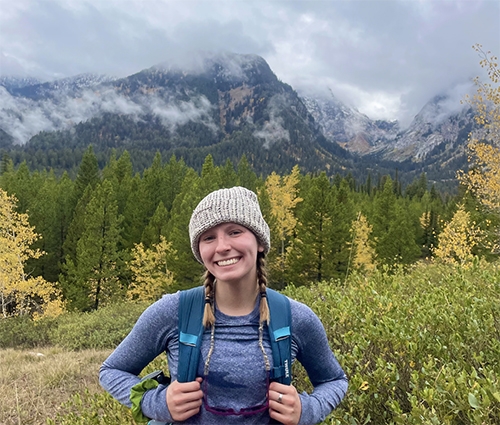
Over the next three years, she learned how to formulate “big research questions,” write proposals, collect data in an orderly way, interpret results, “and perhaps most importantly, how to problem-solve when things go wrong,” says Muscott, an NSF Graduate Research Scholar and Ph.D. student at the University of Utah. “Research with Dr. Larsen developed the lab, field, and interpersonal skills I needed to pursue a graduate degree.”
Muscott’s research focuses on reconstructing drought events in the Holocene era (the last 11,700 years of the Earth’s history) and assessing the corresponding ecological responses by analyzing ancient DNA in lake sediments collected from Summit Lake, Nev. She got involved in this project as an undergraduate, collecting sediment cores and performing preliminary sedimentary analyses.
“Some days I camp beneath a glacier while collecting sediment cores from frozen lakes, touch 13,000-year-old volcanic ash, or study 200-million-year-old rock formations,” says Muscott, who sees herself staying in the research world “for as long as possible” and continuing to pursue questions about Holocene climate change as a research scientist at the U.S. Geological Survey or as a professor at a small liberal arts school like Oxy.
“To me, a successful career looks like learning more about the world around me every day, contributing to the rich body of climate change research, inspiring future generations of geoscientists, and continuing to advocate for women in STEM.”
Namandjé Bumpus ’03
On April 6, the FDA withdrew its approval of Makena, a drug used to lower the risk of premature birth in a woman who has already had one premature baby, after 12 years on the market. In issuing the decision, FDA Chief Scientist Namandjé Bumpus acknowledged the “serious problems of preterm birth” among Black women, adding, “Our hope is that this decision will help galvanize further research.” The announcement was perhaps the most visible insight into her work as the FDA’s chief scientist since Bumpus was named to the role on June 30, 2022.
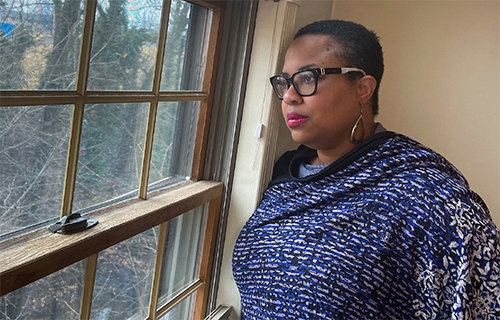
Can you talk about your path to this job?I was a biology major at Oxy and that is where my life as a researcher began. After Oxy, I earned a Ph.D. in pharmacology at the University of Michigan and completed a postdoctoral fellowship at the Scripps Research Institute. At each of those stages, my research focused on biomedical science and gaining a deeper understanding of the impact of drugs on the body. Following my training, I joined the faculty at Johns Hopkins University School of Medicine and rose through the ranks to become an endowed full professor and chair of the Department of Pharmacology and Molecular Sciences. I led a research laboratory and my research centered on understanding molecular mechanisms underlying differences between people in drug outcomes. Through this I began to learn about the work at the FDA and to build relationships with colleagues there. At Hopkins, I also developed skills in enterprise leadership through my various roles, including as department chair and as an associate dean. When I put all of that together, this job seemed like a great way to grow and to contribute to public health through leveraging my scientific expertise and leadership ability.
The FDA employs 11,000 scientists. What are the most pressing concerns of the Office of the Chief Scientist? At the top of my list is ensuring that we leverage all of our scientific knowledge, resources, and expertise to improve public health. To do so, my office is working to ensure that our scientists have the support they need to carry out important research and that our scientists have connections to one another in a way that facilitates collaboration. We also want to make sure that the public knows that there are thousands of scientists at the FDA carrying out research that underlies our decision making and public health mission. I also have several specific priorities as chief scientist, including: implementation of the Modernization of Cosmetics Regulation Act, advancement of laboratory and in silico [computer] approaches that can be used to predict human responses to things like medical products and components of food, clinical trial diversity, gene modification science, and advisory committee optimization.
What is a typical day like for you?I attend meetings on a range of topics. I meet internally with colleagues at FDA to discuss areas and decisions that involve science. I meet with our scientists to discuss their work and especially enjoy days where I get to look at experimental data and even spend time in a lab. I hold listening sessions and meetings with external groups to learn what is important to them and the people they represent. I also meet with other government agencies to discuss coordination around science and related areas. Some days I go to Capitol Hill to provide briefings on various priority areas and topics within the scope of my role.
Is there a trust problem in public health—and if so, what can be done to address that? Thereare opportunities to enhance communication around science and how science is used in decision making. As FDA chief scientist, I hope to play a proactive and strategic role in providing robust and accurate information to the public regarding foundational scientific topics as well as the science-based information they need regarding medical products and foods to maintain and improve their health. I believe that communication of science, particularly in the context of public health, is a critical long-term priority.
What is the most fulfilling part of your job?I enjoy being a public servant. Feeling that my work can have a very direct impact on public health. There is something very special about the FDA. I get to think very carefully about fundamental science and how we can generate knowledge in that space, while at the same time doing so in the context of answering specific questions that will enable us to make important decisions related to our mission. I also am greatly fulfilled by supporting scientists and doing all that I can to enable them to thrive in their research and broader career.
What are the benefits of a liberal arts education to a career in the sciences?It provides a wonderful background for a career as a scientist, including scientific leadership. The opportunity to perform research early on as an undergraduate certainly springboarded my own development as a scientist, and the relationships I built with professors provided much-needed space to grow and establish confidence in doing scientific research. A liberal arts education provides substantial opportunities to deep-dive into various topics and to learn how to be analytical in expressing scientific ideas. It’s a strong foundation for a scientific career.
Griffin Mead ’14
As a research chemist at the National Institute of Standards and Technology (NIST) in Boulder, Colo., Griffin Mead performs atmospheric measurements of the greenhouse gas methane using a highly accurate measurement technique called dual frequency comb spectroscopy. “Methane is released by many sources, including livestock emissions and leaks from oil and gas wells,” he explains. “I’ve tried to combine atmospheric models with the dual frequency comb technique to evaluate and improve regional methane emissions maps. I really enjoy bringing together different sets of data—time series of methane concentrations, meteorological models, historical data on well locations, etc.—into a single cohesive story that explains something about the world.”
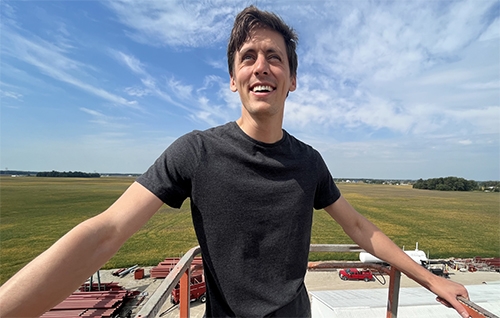
Prior to joining NIST in February 2021, Mead earned a Ph.D. in physical chemistry at Caltech. As a chemistry major at Oxy, he did all of his research with Andrew Udit. “One thing I really enjoyed about working with Andrew was how interdisciplinary his research could be,” Mead says. “There’s not a great deal of overlap between synthesizing organic molecules and blood clotting assays, but I got to explore both of these techniques—and much in between—while working with Andrew. He also made the next steps of becoming a scientist (Ph.D., postdoc) seem achievable and worthwhile.”
Mead fondly recalls his time in Norris Hall of Chemistry: “You could stand for hours at a fume hood, entirely engrossed in an experiment. Friends from other labs down the hall might pop in and chat or try to find a piece of equipment. It was an exciting environment to be in, where learning became fun—if not easy.”
JP Flores ’21
Whether he’s podcasting ( From where does it STEM?, with 21 episodes to date), interning with the National Institutes of Health, or pursuing a Ph.D. in bioinformatics and computational biology at the University of North Carolina at Chapel Hill, John Patrick “JP” Flores is “always keeping busy,” as Professor of Biology Joseph Schulz puts it. His research in the Phanstiel Lab involves studying the role of 3-D chromatin structure in response to environmental stress.
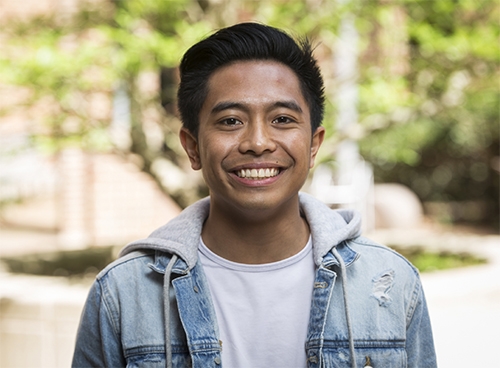
“If you hyperosmotically stress cells (like with salt, for example), the cells will lose most, if not all, of their chromatin architecture,” explains Flores, an NSF Graduate Research Fellow. “Through an experimental technique called Hi-C, we were able to identify a couple hundred gained chromatin loops that we think are upregulating response genes so that the cell can adapt to the stress. This gives us insight into how cells respond to different kinds of stress, which is common in tumor microenvironments.” Flores’ project investigates how stresses such as hypoxia, heat shock, hyperosmotic shock, and disease impact chromatin structure and how the cell may adapt to them through regulation of genes via dynamic nuclear architecture.
In addition to an upcoming internship at the NIH Office of Science Policy, Flores will be working with National Cancer Institute Director Tom Misteli on his dissertation work. “My long-term career goals are quite unorthodox—I don’t think people with Ph.D.s should be siloed into a specific field,” he says. “I want to become a federal scientist with their own lab who is an adjunct professor at a small liberal arts school or minority-serving institution who also is an ad hoc science policy adviser who is also collaborating with folks in industry.”
If that dream gets “too big,” Flores would like to return to Occidental as a professor and manage his own research program here. Looking at the curriculum, he adds, “I’d emphasize integration of classes that may inform the next generation of scientists why we also need to be aware of societal problems. I think a biology class developed in collaboration with the Critical Theory & Social Justice Department would be so cool.”
Emily Hawkins ’14
Emily Hawkins hadn’t given much thought to how the universe works before taking a physics class during her senior year of high school. “This course brought a new level of challenge that invigorated a curiosity in various physics phenomena within me,” says Hawkins, who majored in physics at Oxy and is now a tenure-track assistant professor of physics in the Seaver College of Science and Engineering at Loyola Marymount University.
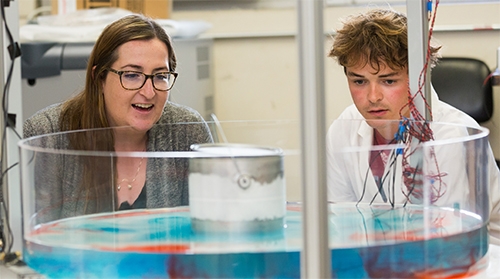
Thanks to Alec Schramm, the Ezra Frederick Scattergood Professor of Physics at Oxy, Hawkins interned for two years with a researcher at NASA’s Jet Propulsion Laboratory who was carrying out an experimental study to characterize cryovolcanism (the eruption of water and other liquid- or vapor-phase volatiles) on planetary bodies including Titan, the largest of Saturn’s 124 moons. “The experience ignited a great passion in me to further study planetary physics and to find a way to make a career out of doing so,” she says.
Of her coursework at Oxy, a Mathematical Methods in Physics class (PHYS 310) she took as a junior with Schramm remains particularly memorable. “Professor Schramm took special care to provide numerous problems for us to solve that motivated the beauty of taking advantage of mathematical properties to solve a variety of interesting and nonintuitive physics problems,” she says. “It undoubtedly changed my development as a physicist.”
Hawkins went on earn her M.S. and Ph.D. in geophysics and space physics at UCLA, completing her studies in 2020. In her lab at LMU, “I conduct experiments to characterize fluid motions on a variety of bodies in our solar system and beyond,” she says. “In particular, my experiments use rapidly rotating convecting fluids to better understand how the magnetic field of our planet and others are generated and maintained. The geomagnetic field controls how our compasses work and acts as our invisible shield, protecting us from harmful levels of solar radiation.”
Her latest endeavors at LMU involve constructing a new experimental device designed specifically to study the physical properties of the subsurface oceans of icy moons such as Enceladus and Europa (moons of Saturn and Jupiter, respectively). “We need to better understand the ocean dynamics within these bodies,” says Hawkins, who is working closely with collaborators on NASA’s Europa Clipper mission—scheduled to launch in October 2024—“to help constrain the potential for observing life elsewhere in our solar system.”
Now in her third year at LMU, Hawkins has several undergrads working with her to study icy world habitability. “I greatly enjoy mentoring students,” she says. “There is nothing quite like watching a student grasp a new and challenging physics concept and seeing their ‘light-bulb moment’ occur, as clichéd as it may sound.”
Reflecting the various interests of LMU’s physics and engineering students, Hawkins supervises several smaller projects “that are equally fun and fascinating,” she says. “I am mentoring a team of students to design and construct a form-factor CubeSat to launch into space to explore the behavior of a magnetic pump in microgravity”—a new technology that could improve astronauts’ quality of life. The project grew out of conversations with a number of her students, she notes: “It is thrilling to continue to work with them outside of the classroom as we learn together.”
Nicole Leung ’11
Growing up in Hong Kong, Nicole Leung spent much of her childhood on the university campuses where her father was a professor of microbiology. After he left academia to start a diagnostic laboratory, she designed the lab’s logo and website. “When I was old enough to step into the lab, I was hooked,” says Leung, who majored in biochemistry at Oxy and worked in the lab of Professor of Biology Joseph Schulz.
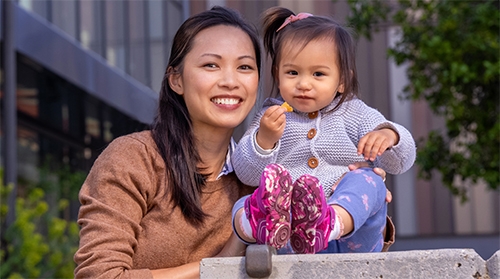
Leung’s graduate research in the Craig Montell Lab at UC Santa Barbara focused on the functions of opsins in taste. “I made the surprising discovery that visual opsins in the fruit fly also function as bitter chemical receptors in taste,” she explains. “We suggest that opsins may have been chemical sensors first and subsequently co-opted their ability to sense light.” For her postdoctoral research in the Nirao Shah Laboratory at Stanford, Leung focused on the molecular and cellular basis of neuronal plasticity in the female mouse brain.
After welcoming daughter Maile early last year, Leung stepped away from the lab to devote more time to being “the mom that I wanted to be,” she says. In her current role as scientific grant writer for the Gladstone-UCSF Institute of Genomic Immunology, she prepares research proposals that blend the latest genomics and genome-engineering technologies with immunology research to engineer the human immune system for therapeutic benefit. “I am hopeful that if I decide to return to pursuing an independent investigator role in academia, there will be opportunities and avenues of support for me,” she says. “I’m incredibly grateful for my current role at the institute and I am loving chasing after my extraordinarily active and bright 1-year-old. Motherhood has taught me that happiness—joy in work and joy in life—is the ultimate success.”
Will Reeves ’16
“As a kid I was infatuated with Lego and excelled in math, which eventually led to my enjoyment of STEM,” Will Reeves recalls. “From classic egg-drop contests to looking at cells under microscopes and creating compounds in lab, I loved all of the middle school science experiments.” On a campus visit to Oxy as a high school senior, Reeves sat in on a class taught by Professor of Kinesiology Stuart Rugg. “His energy was unmatched, which made me excited about learning from him.”
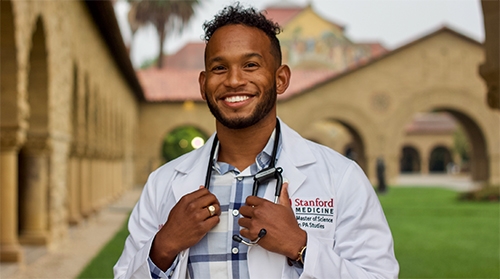
Reeves majored in kinesiology and also worked closely with Associate Professor of Chemistry Aram Nersissian. Under Nersissian’s guidance, Reeves and his fellow students discovered a novel anticoagulant, for which they were honored by the American Society of Hematology. “Professor Nersissian [who died in 2017] encouraged me to be more confident about my ability to execute in and outside of the classroom,” he says. “When I doubted myself, he inspired me to be better.”
While working toward an M.S. in physician assistant studies at Stanford University School of Medicine, Reeves gravitated toward the Stanford Byers School of Biodesign. He and a classmate, Thomas Beck, came up with a business idea based on Beck’s experience as an immunology Ph.D. “Our objective was to use thermal imaging to detect and predict flares for rheumatoid arthritis to enable patients to remotely and objectively record these episodes and further inform their subsequent treatment,” he says. It became clear that such a product could improve care and quality of life for someone with chronic illness, so Reeves, Beck, and a colleague, Ryan Kellogg, developed an app, RTHM HandScan, to revolutionize at-home management of chronic conditions through AI-powered technology.
“When I think about the future of supplementing my practice with technology, I can imagine scaling the positive impact medicine will have on patients’ lives, and I could not be more excited,” he says. “My favorite part of my work is seeing a smile on a patient’s face when they have made progress or even receiving a simple ‘Thank you.’”
Cecilia Prator ’12
“When I began at Occidental, science was just one of my many interests,” Cecilia Prator says. “I loved history and languages. I loved Modernist literature and Renaissance poetry. I’d always envisioned a career spent in the humanities. It wasn’t until my time at Oxy that I really began to see a future where science took center stage.”
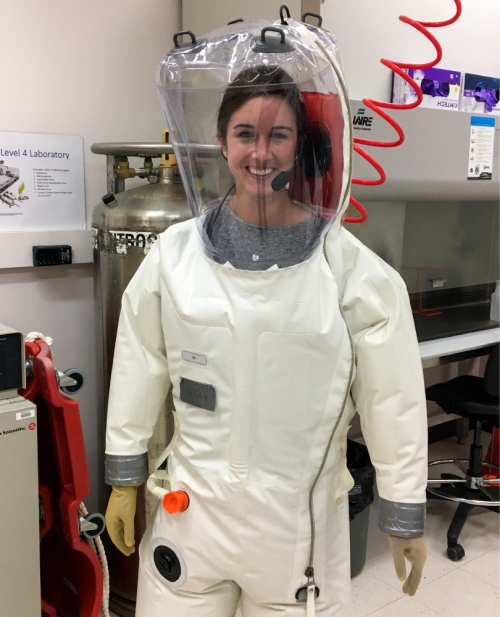
Under the supervision of Professor of Biology Joseph Schulz, Prator cleaned cone snail tanks and collected venom to facilitate the lab’s research. “Professor Schulz quickly showed me how exciting research could be. I’d ask questions about the cone snails, and more often than not, he would respond: ‘We don’t know. Nobody has studied that before.’” Just like the childhood summers she spent camping with her family in the Sierras, turning over rocks and crawling beneath logs searching for salamanders, her time in the Schulz lab kindled a passion for discovery—or, as Prator puts it, “Curiosity lit a fire in me.”
In the 11 years since she graduated from Occidental as a biology major, Prator’s research on viruses has taken many twists and turns. “From grapevine viruses to HIV, deep-sea extremophile viruses to working to develop an Ebola vaccine in a Biosafety Level 4 containment setting at the NIH’s Rocky Mountain Labs, I’ve tried to understand everything about different viral systems, using some of the most advanced tools we have,” says Prator, who, after a yearlong Fulbright fellowship in Brisbane, Australia, attended UC Berkeley for a Ph.D. in virology.
After 19 months as a postdoctoral fellow in the Laboratory of Virology at the National Institute of Allergy and Infectious Diseases, Prator took a new role as a computational biologist at Ginkgo Bioworks, a biotech company based in Boston, in February. “My work on the bioinformatics team focuses on identifying pathogens and understanding trends in the virus evolution,” she says. “We partner with the CDC and other governments and public health entities to spearhead a global pathogen monitoring network. We monitor wastewater samples from arriving aircraft and nasal swab samples, collected on a voluntary, anonymous basis from arriving international travelers, for SARS-CoV-2 and other pathogens.”
She adds: “The work we’re doing at Ginkgo sits at the frontier of biosecurity technology. We’re working to help solve real problems with real-world impacts. We’re using cutting-edge tools and doing that work across the globe. We’re striving to improve public health worldwide.”
Prator’s latest project brought her to Rwanda, where she’s supporting the growth of the government’s bioinformatics team as it develops its biosecurity programs. “Not only is it rewarding to work alongside brilliant scientists in Rwanda and beyond, but there’s a real sense of personal fulfillment that comes with helping to battle a global deadly pathogen,” she says. “After a decade-plus of training, it feels good to put my skills to use for a good cause.”
Jason Preble ’14
Of all his science professors at Oxy, Joseph Schulz made the most impact on Jason Preble’s development as a scientist. “I joined his research lab during my sophomore year because he conducted field research and his field sites were in Hawai‘i,” says the biology major, who grew up in Kaneohe.
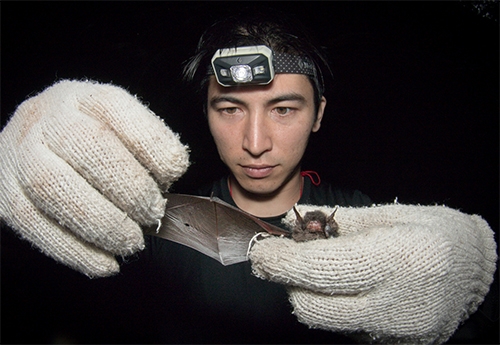
After studying endangered birds in New Zealand as a Fulbright Scholar, Preble enrolled in a Ph.D. program in biosphere informatics at Kyoto University, publishing his research on the conservation biology of Japanese bats and completing his degree in 2022.
Preble’s interest in ecosystem restoration—“and the bottlenecks that keep us from doing more of it”—led to his current work as forestry partnerships lead at Terraformation, a Hawai‘i-based startup founded by former Reddit CEO Yishan Wong that is trying to help scale native biodiverse forest restoration worldwide and maximize the carbon drawdown potential of forests to combat climate change.
“I never thought I’d be working for a climate startup, but Terraformation understands how interconnected the climate and biodiversity crises are, so our work and values line up well with my interests,” says Preble. He is responsible for identifying participants for the company’s Seed to Carbon Forest Accelerator program, which connects organizations looking to scale up their forest restoration efforts with carbon financing and other tools.
“I love that I am always learning, and my favorite part of the job is speaking with and trying to help ecosystem restoration projects from all over the world,” he says. “Even though our cultures and geographies might be totally different, it’s uplifting to work collaboratively with so many people trying to improve the health of our planet, its biodiversity, and its people.”
Shawna Hollen ’05
For many years, Shawna Hollen saw her Oxy mentor, Occidental Professor of Physics George Schmiedeshoff, at the annual American Physical Society March Meeting. “He always came to see my talks and take me out for dinner—‘Once a student, always a student, and students never pay,’ he’d say,” she recalls. Schmiedeshoff died in 2019—“a huge loss” for Hollen: “I wish I had more time to tell him what an impact he had.”
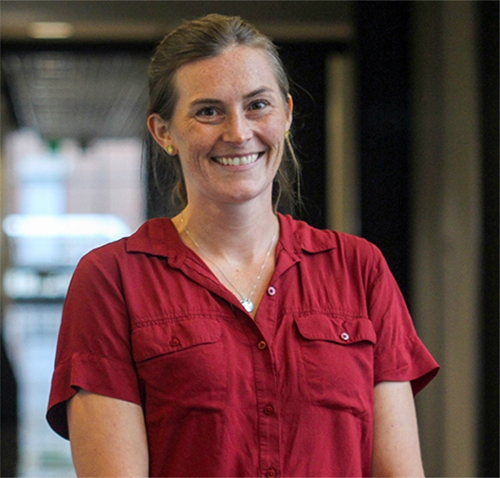
An associate professor of physics at the University of New Hampshire, Hollen leads a group that uses a scanning tunneling microscope (STM) at very low temperatures (10°K) to measure electronic properties of materials. “We are particularly interested in how disorder, defects, and the local electrostatic environment can control the electronic properties and quantum phases of 2-D materials—single atomic or molecular layers,” she explains. “In one of our current projects, we are using tools at Brookhaven National Laboratory to assemble two- and three-layer stacks of tantalum disulfide with a little twist between the layers. Tantalum disulfide has a curious feature in which the electrons bunch up in a triangular pattern. We think by controlling the interaction between the layers with the twist angle, we will be able to control this triangular pattern of electrons as well as the electronic states associated with it.”
As a participant in Oxy’s Undergraduate Research Program, Hollen did summer research with Professor Daniel Snowden-Ifft building a dark matter detector and thinking that she wanted to go into astrophysics. But “the funky behavior of particles in solids drew me back into the fold in graduate school,” she says, “and I am now proudly a condensed matter physicist.”
Since Hollen arrived at UNH in 2015, she has mentored 14 undergraduate students in research projects. “Watching students develop from the phase of dipping toes in the water to fully independent research is the most rewarding experience of my career,” she says.
Jeremiah Ray ’06 & Anne Davis Ray ’06
“I am confident the universe led me to Occidental,” says Anne Davis Ray. Growing up in Edgewater, Md., “The odds that I would end up at Oxy were slim, but it led me to all the best parts of my life now—my husband, my career, and our family together.” Anne arrived at college with a tentative plan to pursue history and economics, but decided to get her science requirement “out of the way” her first semester. Professor Don Deardorff’s chemistry class “proved to have the magical combination of challenge and discovery that lit up my intellectual curiosity and made me want to push further,” says Anne, who graduated from Oxy as a biochemistry major and completed her M.D. at UCSF.
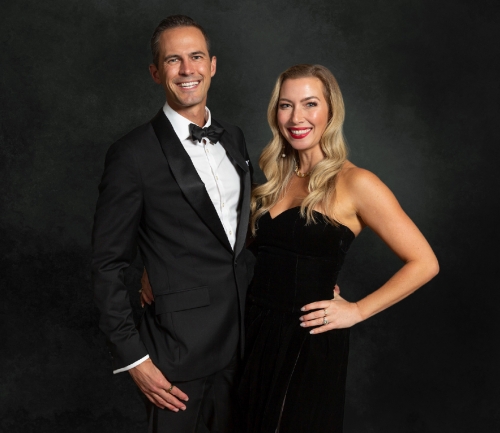
Fellow biochemistry major Jeremiah Ray grew up in Jackson and fell in love with human physiology as a second-grader. “My father attended night classes at the nearest community college to earn his nursing degree,” he recalls. A babysitter was not an option, so for the next 24 months Jeremiah sat, enthralled, in many of his dad’s classes. “I could not contain my excitement and provided a voluntary lecture to my third-grade class on the flow of deoxygenated blood from the vena cava, through the right side of the heart, to the lungs, back to the left side of the heart,” says Jeremiah, who graduated from the Stanford University School of Medicine and completed his residency training in emergency medicine at the University of Utah School of Medicine.
Anne’s focus now in her career as lead physician for the Hoag On-Demand Care & Innovation Center in Newport Beach is bridging the benefits of old-fashioned, comprehensive primary care with new technologies to create patient-centered solutions for the future. “We promote wellness and a model of care that puts patients’ needs and convenience at the forefront while creating efficient models of work for physicians,” she says. “I love being able to design new and more efficient and effective systems of care, not being limited to being a ‘cog in the machine’ of traditional medicine.”
After four years as the head team physician overseeing intercollegiate athletic sports medicine at UC Davis, Jeremiah now serves as team physician for the Los Angeles Chargers through his work at Hoag Sports Medicine. The most enjoyable part of his work is “blending a rigorous understanding of anatomy and physiology to diagnose a complex presentation and then teaching my patient the ‘why’ their injury has occurred,” he says. “The combination of diagnosing, teaching, and then intervening to make a human well again is simply wonderful.”
Retracing her own “unconventional” path to a medical career, Anne encourages Oxy students to broaden their horizons: “When you find something that lights you up, follow that, even if it feels ‘off track.’ It might just be the track you’re supposed to be on in the first place.”
Lynn He ’19
Lynn He entered Oxy thinking she would be an economics major, but one class with Professor of Chemistry Mike Hill changed her mind. Hill offered her a summer research position, and “I had so much fun doing crazy experiments in his lab and being mentored by the older students in the lab that it made me believe that I could not only be a scientist but a good one,” He recalls. She wound up majoring in chemistry with double minors in art history and math.
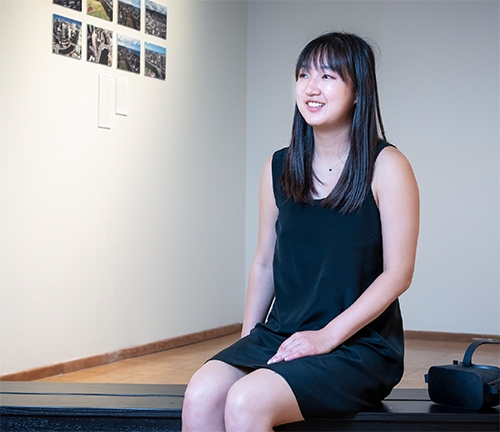
As a Fulbright research grant recipient, He spent a year using spectroscopic analysis to examine an archive of Chinese paintings at Sichuan University in Chengdu, China, while also learning about traditional Chinese conservation methods. “Art historians often have to pore over thousands of works to identify visual similarities and motifs in order to propose art historical theories,” she says. “My research focused on helping automate that process.” While this technology was available for Western oil paintings, He worked with art history and computer vision experts in Sichuan to develop AI for non-Western art traditions.
In an effort to “stay fresh” on AI during the pandemic, He began working for DeepLearning.AI, an education technology company founded by Andrew Ng, a pioneer in machine learning. She developed lectures and coding exercises for the Deep Learning Specialization on Coursera and worked closely with Ng on developing Data-centric AI—the discipline of systematically engineering the data used to build an AI system. He built and ran the first Data-centric AI competition, which drew thousands of submissions, and co-authored a paper with Ng on the subject.
Last August, He enrolled in law school at UC Berkeley, after which she intends to go into tech policy. “There are so few protections for people against irresponsible AI deployment,” she says. “I am interested in raising awareness about the way AI impacts our lives and, more specifically, propagates systems of discrimination.”
AI is commonly used in tenant screening processes, He notes, and plays an ever larger role in the prison industrial complex. “There will be hardly any person who is not impacted by AI,” she adds. “It’s important that we develop the moralities and protections to go with it.”
At Berkeley, He says, “I have been so lucky to find people who share similar passions and care about the way technology is harming the people around us.” And just as at Oxy, she feels grateful to be mentored by professors “who believe in me more than I do. I feel a deep sense of meaning and purpose in my work, and I just feel incredibly lucky to be where I am.”
Natalie Dwulet ’17
“For as long as I can remember, science was my favorite subject in school,” says Natalie Dwulet. “I was interested in attending Occidental because I wanted a small liberal arts school where I could be a student- athlete [she was a starting middle for the Tigers volleyball team as a first- year, putting away 10 kills in a 3-2 win at Chapman in the final game of the season] and retain a strong focus on my academics.”
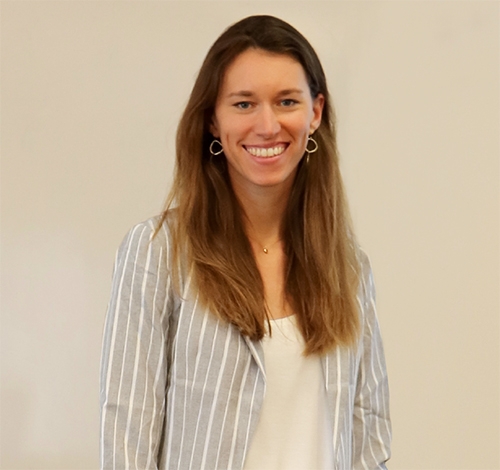
Although she planned to major in biology when she arrived, an Organic Chemistry 1 class with Linda Lasater “changed my whole trajectory at Oxy,” Dwulet says. She became a chemistry major and started working her sophomore year in the laboratory of then-new Assistant Professor Jeff Cannon ’07. “I was one of his first research students,” says Dwulet, who was awarded an NSF Fellowship grant for graduate school.
Last July, Dwulet completed her Ph.D. in chemistry at UC Irvine, where her research focused on the total synthesis of a “challenging natural product with interesting biological activity.” Her work was recently published in the Journal of the American Chemical Society.
After graduation, Dwulet took a job as a senior scientist with Pfizer in its oncology program. “Our work is focused on small molecule drug discovery, specifically on targeted therapeutics for the treatment of many different cancers,” says Dwulet, who works at Pfizer’s state-of-the-art research site in Boulder, Colo.
The most enjoyable aspect of her work, she adds, is “getting to solve challenging problems. Occidental gave me an incredibly strong foundation for graduate school and my continued development as a scientist.”
Ian Van Dusen ’20
“I’ve always been fascinated by puzzles and understanding complex systems,” says Ian Van Dusen, who majored in geology at Oxy. “My view of science is to determine which factors affect different pieces of the overall puzzle and get to the root of the cause”—and in the case of his research, that means using remote sensing techniques to isolate various driving factors affecting the Earth’s surface.
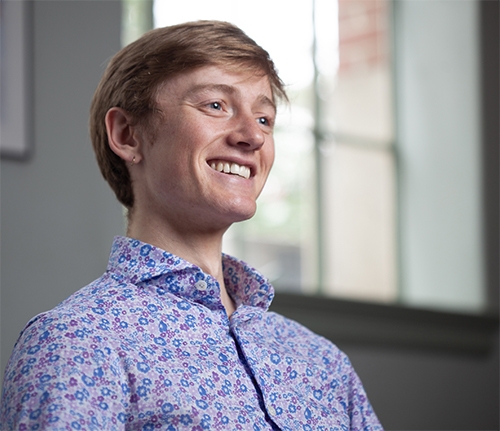
While Van Dusen was attracted to Oxy by the opportunity to have “intimate, intense classes while being in one of the biggest cities in the country,” he discovered that the College was a hub to study science as well. “Due to fantastic weather, we had year-round geology field trips—to the Eastern Sierra, southern Utah, and the California coast,” he says. “Oxy turned out to be a great place to learn about the natural world.”
As a sophomore, Van Dusen took Associate Professor Darren Larsen’s Introduction to Earth’s Climate class. “This was formative because we learned how Earth’s climate is understood leveraging many different historical records. I greatly valued learning how to synthesize data from multiple sources to understand and piece together climate history.” The class culminated in a field trip along the Eastern Sierra, where they mapped and investigated evidence of previous glaciations.
As a graduate student in geography at the University of Oregon, Van Dusen is working with Professor Sarah Cooley on a NASA Commercial Smallsat Data Acquisition (CSDA) grant to study the accuracy of satellite-derived water maps relative to ground observations of shorelines. “In the last 10 years, there has been rapid development in remote sensing resources,” he says. Expanding remote sensing data will better assist scientists in predicting river discharge and flooding patterns.
Regarding his long-term career goals, Van Dusen wants to work in geospatial analytics. “Developments in satellite-based geospatial data give a new perspective to monitoring Earth surface processes and change,” he says. While the boom in geospatial technology has predominantly benefited large companies, he envisions many ways for smaller organizations to incorporate geolocation data to improve understanding and efficiency.
“I would love to start a company that leverages remote sensing data and analytics to aid small farms and urban planning in decision-making processes,” he adds. “Accessibility is rapidly increasing, and I have the skill set to bring the benefits of Earth observation to more people.” For someone who likes puzzles, all the pieces are falling into place.
Ian Jan ’20
“I didn’t see many scientists like me from disadvantaged backgrounds growing up,” says Ian Jan—a self-described “bioengineer, maker, and former snail wrangler” who majored in biochemistry at Oxy. Jan is currently pursuing a Ph.D. in bioengineering in the Allbritton Lab at the University of Washington, where he’s developing a novel platform to enable large screens identifying important genes involved in early human embryo development. “Utilizing powerful automation and computational technologies such as artificial intelligence, I can visualize and assess complex developmental processes in the embryonic stem cell model that I’m using,” he says.
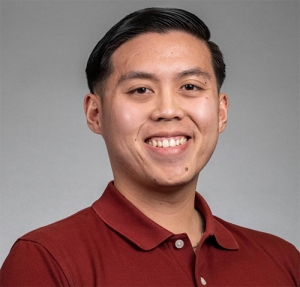
Like his undergraduate research, Jan’s doctoral project is multidisciplinary. “A typical day includes crafting precise cell culture devices via microfabrication, replenishing the growth media for cells, and debugging code used to analyze thousands of fluorescence images,” he says. “My discoveries can provide insights into early pregnancy losses, congenital birth defects, and tissue formation.”
After completing his Ph.D., Jan plans to work in the biotech industry. “In my Introduction to Technology Commercialization course, I became fascinated with entrepreneurship and enjoyed learning the fundamentals of building a startup,” he says. “I developed and pitched a business plan based on a startup idea to a panel of judges for my final project. Subsequently, I aim to pass on the great mentorship I received at Oxy and teach later in my career.
“I wouldn’t be here today without the amazing research experience I had with Professor Joseph Schulz,” Jan adds. “He entrusted me with a challenging project that eventually led to publication—and the front cover—in a high-impact journal, a competitive science fellowship, and a talk at a national science conference. I developed resiliency, creativity, and critical thinking skills that I apply every day. I’m the scientist that I am because of all the support from my family, friends, and mentors. By pursuing greater heights in science, I hope my story proves to others in similar situations that they can, too.”
Kristina Chang ’16
“Being a scientist teaches you to appreciate the natural world with a certain level of depth and specificity,” observes Kristina Chang. “The simple exercise of asking a few scientific questions transforms something seemingly mundane in the physical world into something extraordinary and exciting.”
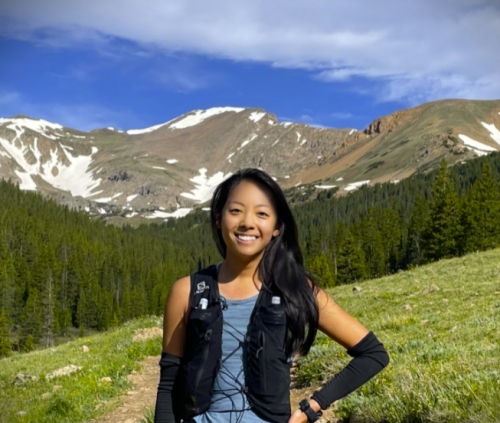
Chang’s research centers on building new laser-based tools to elucidate the behavior and properties of atoms, molecules, and materials. “In my Ph.D., I developed some of these tools to directly observe and understand some of the fastest processes in chemistry, such as electrons moving around in molecules,” says Chang, who completed her doctoral work at UC Berkeley in 2021.
As a National Research Council postdoctoral fellow at the National Institute of Standards and Technology in Boulder, Colo., Chang is developing similar tools with the aim of measuring the arrangement of electrons in matter with extremely high precision.
“My work as a researcher challenges me constantly, and in a way that allows me to learn continuously, commit to curiosity, and grow with others,” she says. “Scientific research explores the limits of what we know and pushes those boundaries—an adventure not unlike mountain climbing. There will be bad weather, or bad luck. The path forward is painstaking, and often isn’t clear at all.”
But in science, she adds, “You never have to go it alone. The relationships you form with fellow researchers, mentors, and mentees while tackling those challenges make it all the more worthwhile. The views from the summit”—such as seeing bonds break in a molecule for the first time—“are breathtaking as well.”
As a double major in chemistry and math, “I took a majority of my classes in those departments, and I can’t thank the faculty there enough,” Chang says. “My professors made me feel seen and supported, and they have had a lasting positive effect on my life.”
To graduating Oxy students just starting their careers, she says: “If it seems like no one in your new job, field, or area of work seems to have quite the same background as you, don’t be afraid to pave your own path. The more you see your life as an N=1 experiment, the less likely you’ll be to miss opportunities. It’ll thicken the plot in a good way!”
Katherine Forbes ’18
Associate Professor of Chemistry Jeff Cannon ’07 played an instrumental role in Katherine Forbes’ development as a scientist. “I joined Jeff’s research lab in my junior year, and I learned so much from him,” she says. “He taught me to analyze data, edited my proposals, walked through chemistry problems with us to train us how to think, and was always there when I had a question. Jeff prepared me for graduate school in innumerable ways, and he is the main reason I was able to become independent so early on in my grad school research.”
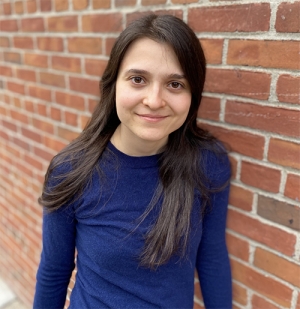
Having recently completed her Ph.D. work at Harvard University, Forbes’ research in the lab of Professor Eric Jacobsen was focused on synthetic organic chemistry, specifically using chiral hydrogen-bond-donor catalysts for the enantioselective synthesis of phosphorus-based stereocenters. “One of the best parts about graduate school was that I had the opportunity to gain a greater understanding and appreciation for different fields of research that I would not have otherwise known about, such as chemical biology,” she says.
Forbes also had the opportunity to teach undergraduate and graduate-level organic chemistry courses during her time at Harvard, and served as president of the Graduate Student and Postdoc Council for the Department of Chemistry & Chemical Biology. “I am still figuring out my career aspirations,” says Forbes, who is working on a medicinal chemistry team at Vertex Pharmaceuticals.
The most enjoyable aspect of her current role, she says, is working to develop solutions to very important health problems as part of a team. Compared to grad school, “Projects move very quickly and efficiently here,” she adds, “but the problems we face are also much more complicated. Developing novel therapeutics is not a trivial task, and every day I learn more about the complexities of the drug development process.”

